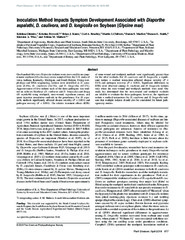Приказ основних података о документу
Inoculation Method Impacts Symptom Development Associated with Diaporthe aspalathi, D. caulivora, and D. longicolla on Soybean (Glycine max)
| dc.creator | Ghimire, Krishna | |
| dc.creator | Petrović, Kristina | |
| dc.creator | Kontz, Brian | |
| dc.creator | Bradley, Carl A. | |
| dc.creator | Chilvers, Martin I. | |
| dc.creator | Mueller, Daren S. | |
| dc.creator | Smith, Damon L. | |
| dc.creator | Wise, Kiersten A. | |
| dc.creator | Mathew, Febina M. | |
| dc.date.accessioned | 2021-04-26T19:47:42Z | |
| dc.date.available | 2021-04-26T19:47:42Z | |
| dc.date.issued | 2019 | |
| dc.identifier.issn | 0191-2917 | |
| dc.identifier.uri | http://fiver.ifvcns.rs/handle/123456789/1915 | |
| dc.description.abstract | One hundred fifty-two Diaporthe isolates were recovered from symptomatic soybean (Glycine max) stems sampled from the U.S. states of Iowa, Indiana, Kentucky, Michigan, and South Dakota. Using morphology and DNA sequencing, isolates were identified as D. aspalathi (8.6%), D. caulivora (24.3%), and D. longicolla (67.1%). Aggressiveness of five isolates each of the three pathogens was studied on cultivars Hawkeye (D. caulivora and D. longicolla) and Bragg (D. aspalathi) using toothpick, stem-wound, mycelium contact, and spore injection inoculation methods in the greenhouse. For D. aspalathi, methods significantly affected disease severity (P lt 0.001) and pathogen recovery (P lt 0.001). The relative treatment effects (RTE) of stem-wound and toothpick methods were significantly greater than for the other methods. For D. caulivora and D. longicolla, a significant isolate x method interaction affected disease severity (P lt 0.05) and pathogen recovery (P lt 0.001). Significant differences in RTEs were observed among D. caulivora and D. longicolla isolates only when the stem-wound and toothpick methods were used. Our study has determined that the stem-wound and toothpick methods are reliable to evaluate the three pathogens; however, the significant isolate x method interactions for D. caulivora and D. longicolla indicate that multiple isolates should also be considered for future pathogenicity studies. | en |
| dc.publisher | Amer Phytopathological Soc, St Paul | |
| dc.relation | North Central Soybean Research Program | |
| dc.relation | South Dakota Soybean Research and Promotion Council | |
| dc.relation | South Dakota Agricultural Experimental Station [H527-14] | |
| dc.rights | openAccess | |
| dc.source | Plant Disease | |
| dc.subject | Diaporthe | |
| dc.subject | isolates | |
| dc.subject | soybean | |
| dc.title | Inoculation Method Impacts Symptom Development Associated with Diaporthe aspalathi, D. caulivora, and D. longicolla on Soybean (Glycine max) | en |
| dc.type | article | |
| dc.rights.license | ARR | |
| dc.citation.epage | 684 | |
| dc.citation.issue | 4 | |
| dc.citation.other | 103(4): 677-684 | |
| dc.citation.rank | M21 | |
| dc.citation.spage | 677 | |
| dc.citation.volume | 103 | |
| dc.identifier.doi | 10.1094/PDIS-06-18-1078-RE | |
| dc.identifier.fulltext | http://fiver.ifvcns.rs/bitstream/id/843/1912.pdf | |
| dc.identifier.pmid | 30742552 | |
| dc.identifier.scopus | 2-s2.0-85064722090 | |
| dc.identifier.wos | 000462807700074 | |
| dc.type.version | publishedVersion |


